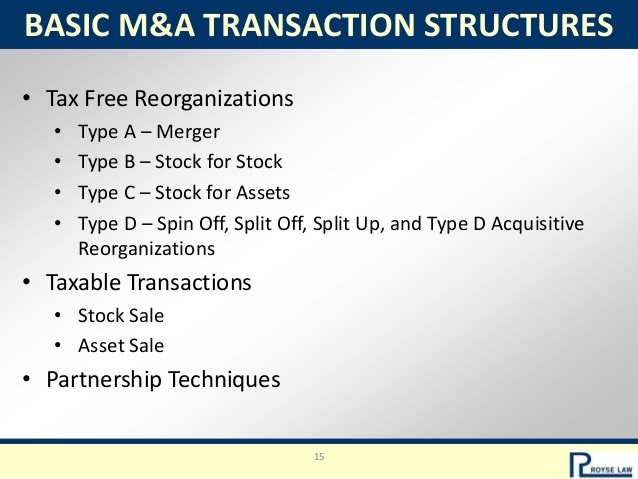TaxFree Acquisitions
Post on: 26 Апрель, 2015 No Comment

Tax-free M&A transactions are considered reorganizations and are similar to taxable deals except that in reorganizations the acquirer uses its stock as a significant portion of the consideration paid to the seller rather than cash or debt. Four conditions must be met to qualify a transaction for tax-free treatment under Internal Revenue Code (IRC) Section 368:
- Continuity of ownership interest At least 50% of the consideration is acquirer stock (although transactions with as little as 40% stock consideration have qualified for tax-free treatment).
- Continuity of business enterprise The acquirer must either continue the target’s historical business or use a significant portion of the target’s assets in an existing business for 2 years after the transaction.
- Valid business purpose The transaction must serve a valid business purpose beyond tax avoidance.
- Step-transaction doctrine The transaction cannot be part of a larger plan that, taken in its entirety, would constitute a taxable acquisition.
Reorganizations, while not generally taxable at the entity level, are not completely tax-free to the selling shareholders. A reorganization is immediately taxable to the target’s shareholders to the extent they receive non-qualifying consideration, or boot. Also, tax on acquirer stock received by target shareholders as consideration is deferred rather than avoided altogether.
Boot
Any consideration received by target shareholders other than acquirer stock (e.g. cash or debt).
Let’s examine how each stakeholder in a non-taxable acquisition is affected from a tax perspective:
Acquiring Entity
- Assumes a carryover basis in the acquired net assets equal to the target’s historical tax basis, even when a gain is recognized by the target shareholders on any boot received.
- Assumes a carryover basis in the stock received from target shareholders equal to the target shareholders’ basis, even when a gain is recognized by the target shareholders on any boot received.
- No gain or loss on the exchange of the acquirer’s own stock for stock of the target.
- The target’s tax attributes (e.g. NOLs) survive the acquisition and carry over to the acquirer, but their use is subject to limitation under Section 382.
Target Entity
- Target does not recognize a taxable gain on the transfer of assets to the acquirer.
Target Shareholders
- Target shareholders assume a tax basis in the acquirer stock received as consideration equal to their old basis in the target stock.
- No gain or loss on the exchange of target stock for acquirer stock; rather, any tax on acquirer stock received as consideration is deferred until the target shareholders sell the stock.
- The transaction is immediately taxable to selling shareholders to the extent boot is received.

Example 3.8 Shareholder Taxes
Suppose Alpha acquires Tango in an tax-free reorganization for $60 in cash and $40 in stock. Tango’s shareholders’ aggregate basis in their stock is $20. So, Tango’s shareholders’ realized gain is $60 + $40 $20 = $80. Their recognized gain is the lower of the realized gain and the amount of boot received, or $60.
Tax-Free Deal Structures
Section 368 of the Internal Revenue Code recognizes three types of corporate acquisition structures that qualify as tax-free (or tax-deferred) reorganizations:
- Type A Reorganization (stock-for-assets acquisition)
- Statutory merger or consolidation
- Forward triangular merger
- Reverse triangular merger
Statutory Merger (A Reorganization)
In a statutory merger. target shareholders exchange their shares for acquirer stock and up to 60% boot (continuity of interest requirement applies). Boot is immediately taxable to target shareholders, while payment in acquirer stock is tax-deferred. Stock consideration may be paid in voting and non-voting common or qualified preferred shares of the acquirer. The target is liquidated, and all of the target’s assets and liabilities are assumed by the acquirer. Approval of the merger plan is subject to acquirer and target shareholder vote in most states. Also, dissenting shareholders may have their independently appraised and purchase for cash.
Statutory Consolidation (A Reorganization)
In a statutory consolidation. two or more corporations contribute all of their assets and liabilities to a new corporation formed to effect the transaction, and the preexisting corporations are dissolved. This structure is appropriate for mergers of equals. Acquirer and target shareholders have the same voting and appraisal rights as in a statutory merger.
Forward Triangular Merger (A Reorganization)
In a forward triangular merger, the target is merged into a subsidiary of the acquiring corporation, leaving the subsidiary as the surviving entity. Because the target is eliminated, non-transferrable assets and contracts, such as patents or licenses, may be lost. The buyer must acquire substantially all of the target’s assets (defined as at least 70% and 90% of the FV of the target’s gross assets and net assets, respectively) for the transaction to qualify for tax-free treatment. Sales of assets not wanted by the acquirer just prior to the merger may jeopardize favorable tax treatment.
As in a statutory merger, the form of consideration must meet the continuity of interest requirement and payment in acquirer stock is flexible as to the type of securities used as consideration (payment in subsidiary stock is disallowed). However, this structure has two advantages over a statutory merger: 1) the acquirer is shielded from the target’s liabilities because they are isolated in a separate legal entity (the subsidiary) and 2) the acquirer’s shareholders need not approve the merger, unless the acquisition is material or more acquirer shares must be authorized to complete the transaction.
Reverse Triangular Merger (A Reorganization)
In a reverse triangular merger, a subsidiary of the acquirer is merged into the target, leaving the target as the surviving entity and a subsidiary of the acquirer and eliminating any minority shareholders in the target. This structure allows the acquirer to shield itself from the target’s liabilities, as in the forward triangular merger, but with the added benefit that non-transferrable assets and contracts are not lost. For this reason, the reverse triangular merger is a commonly used structure. However, at least 80% of the consideration must be paid in voting common or preferred stock of the acquirer, eliminating some flexibility in the type of equity consideration paid relative to the forward triangular merger. Other characteristics of this structure are similar to those found in forward triangular mergers, including the substantially all and shareholder approval requirements.
Stock-for-Stock Acquisition (B Reorganization)
In a B reorganization, the acquirer exchanges its voting common and/or qualified preferred stock (no boot, except for small amounts paid for fractional shares) for control of the target, defined as ownership of 80% of the vote and value of the target’s stock. The target survives as a subsidiary of the acquirer, shielding the acquirer from the target’s liabilities. The buyer need not acquire the entire 80% of target stock at once, but must own at least 80% upon completion of the acquisition. This allows the buyer to acquire the target’s shares gradually in what is known as a creeping acquisition. Note that since this structure does not require 100% of the target’s shares to be acquired, minority shareholders may retain a stake in the target. The B reorganization is similar to the reverse triangular merger, except that the latter allows boot, eliminates minority shareholders, and requires the buyer to acquire substantially all of the target’s assets.
This structure may be useful when the target’s shareholders are willing to accept acquirer stock as consideration because, for example, they might have built-in capital gains that would be triggered upon a stock sale for cash. The buyer may also prefer this structure if it does not want to part with a substantial amount of cash to fund the acquisition or seeks to shield itself from the target’s liabilities.
Stock-for-Assets Acquisition (C Reorganization)
In a C reorganization, the acquirer exchanges its voting common and/or preferred stock for substantially all of the target’s assets. The target liquidates and transfers the acquirer shares and any remaining assets to its shareholders. Consideration paid in cash or securities other than voting common or preferred stock (boot) cannot exceed 20% of the FV of the target’s pre-transaction assets. Any liabilities assumed by the acquirer count toward the 20% boot limit when cash or other non-qualifying consideration is paid.
As in taxable asset acquisitions, the buyer can be selective in choosing which, if any, of the target’s assets it will assume. Rejecting the certain liabilities altogether affords the acquirer even greater protection than does isolating those liabilities in a subsidiary. However, the acquirer is highly exposed to any assumed liabilities unless a subsidiary is used to shield that exposure as in other structures. Moreover, like taxable asset acquisitions, the C reorganization can be mechanically complex, costly, and time consuming. Hence, C reorganizations are rare.














